
aiomisc
aiomisc - miscellaneous utils for asyncio
Stars: 388

aiomisc is a Python library that provides a collection of utility functions and classes for working with asynchronous I/O in a more intuitive and efficient way. It offers features like worker pools, connection pools, circuit breaker pattern, and retry mechanisms to make asyncio code more robust and easier to maintain. The library simplifies the architecture of software using asynchronous I/O, making it easier for developers to write reliable and scalable asynchronous code.
README:
.. image:: https://coveralls.io/repos/github/aiokitchen/aiomisc/badge.svg?branch=master :target: https://coveralls.io/github/aiokitchen/aiomisc :alt: Coveralls
.. image:: https://github.com/aiokitchen/aiomisc/workflows/tox/badge.svg :target: https://github.com/aiokitchen/aiomisc/actions?query=workflow%3Atox :alt: Actions
.. image:: https://img.shields.io/pypi/v/aiomisc.svg :target: https://pypi.python.org/pypi/aiomisc/ :alt: Latest Version
.. image:: https://img.shields.io/pypi/wheel/aiomisc.svg :target: https://pypi.python.org/pypi/aiomisc/
.. image:: https://img.shields.io/pypi/pyversions/aiomisc.svg :target: https://pypi.python.org/pypi/aiomisc/
.. image:: https://img.shields.io/pypi/l/aiomisc.svg :target: https://pypi.python.org/pypi/aiomisc/
Miscellaneous utils for asyncio.
As a programmer, you are no stranger to the challenges that come with building and maintaining software applications. One area that can be particularly difficult is making architecture of the software that using asynchronous I/O.
This is where aiomisc comes in. aiomisc is a Python library that provides a
collection of utility functions and classes for working with asynchronous I/O
in a more intuitive and efficient way. It is built on top of the asyncio
library and is designed to make it easier for developers to write
asynchronous code that is both reliable and scalable.
With aiomisc, you can take advantage of powerful features like
worker pools, connection pools, circuit breaker pattern,
and retry mechanisms such as asyncbackoff and asyncretry to make your
asyncio code more robust and easier to maintain. In this documentation,
we'll take a closer look at what aiomisc has to offer and how it can
help you streamline your asyncio service development.
Installation is possible in standard ways, such as PyPI or installation from a git repository directly.
Installing from PyPI_:
.. code-block:: bash
pip3 install aiomisc
Installing from github.com:
.. code-block:: bash
# Using git tool
pip3 install git+https://github.com/aiokitchen/aiomisc.git
# Alternative way using http
pip3 install \
https://github.com/aiokitchen/aiomisc/archive/refs/heads/master.zip
The package contains several extras and you can install additional dependencies if you specify them in this way.
With uvloop_:
.. code-block:: bash
pip3 install "aiomisc[uvloop]"
With aiohttp_:
.. code-block:: bash
pip3 install "aiomisc[aiohttp]"
Complete table of extras bellow:
+-----------------------------------+------------------------------------------------+
| example | description |
+===================================+================================================+
| pip install aiomisc[aiohttp] | For running aiohttp_ applications. |
+-----------------------------------+------------------------------------------------+
| pip install aiomisc[asgi] | For running ASGI_ applications |
+-----------------------------------+------------------------------------------------+
| pip install aiomisc[carbon] | Sending metrics to carbon_ (part of graphite_) |
+-----------------------------------+------------------------------------------------+
| pip install aiomisc[cron] | use croniter_ for scheduling tasks |
+-----------------------------------+------------------------------------------------+
| pip install aiomisc[raven] | Sending exceptions to sentry_ using raven_ |
+-----------------------------------+------------------------------------------------+
| pip install aiomisc[rich] | You might using rich_ for logging |
+-----------------------------------+------------------------------------------------+
| pip install aiomisc[uvicorn] | For running ASGI_ application using uvicorn_ |
+-----------------------------------+------------------------------------------------+
| pip install aiomisc[uvloop] | use uvloop_ as a default event loop |
+-----------------------------------+------------------------------------------------+
.. _ASGI: https://asgi.readthedocs.io/en/latest/ .. _PyPI: https://pypi.org/ .. _aiohttp: https://pypi.org/project/aiohttp .. _carbon: https://pypi.org/project/carbon .. _croniter: https://pypi.org/project/croniter .. _graphite: http://graphiteapp.org .. _raven: https://pypi.org/project/raven .. _rich: https://pypi.org/project/rich .. _sentry: https://sentry.io/ .. _uvloop: https://pypi.org/project/uvloop .. _uvicorn: https://pypi.org/project/uvicorn
You can combine extras values by separating them with commas, for example:
.. code-block:: bash
pip3 install "aiomisc[aiohttp,cron,rich,uvloop]"
This section will cover how this library creates and uses the event loop and
creates services. Of course, you can't write about everything here, but you
can read about a lot in the Tutorial_ section, and you can
always refer to the Modules_ and API reference_ sections for help.
Event-loop and entrypoint +++++++++++++++++++++++++
Let's look at this simple example first:
.. code-block:: python
import asyncio
import logging
import aiomisc
log = logging.getLogger(__name__)
async def main():
log.info('Starting')
await asyncio.sleep(3)
log.info('Exiting')
if __name__ == '__main__':
with aiomisc.entrypoint(log_level="info", log_format="color") as loop:
loop.run_until_complete(main())
This code declares an asynchronous main() function that exits after
3 seconds. It would seem nothing interesting, but the whole point is in
the entrypoint.
What does the entrypoint do, it would seem not so much, it creates an
event-loop and transfers control to the user. However, under the hood, the
logger is configured in a separate thread, a pool of threads is created,
services are started, but more on that later and there are no services
in this example.
Alternatively, you can choose not to use an entrypoint, just create an event-loop and set this as a default event loop for current thread:
.. code-block:: python :name: test_index_get_loop
import asyncio
import aiomisc
# * Installs uvloop event loop is it's has been installed.
# * Creates and set `aiomisc.thread_pool.ThreadPoolExecutor`
# as a default executor
# * Sets just created event-loop as a current event-loop for this thread.
aiomisc.new_event_loop()
async def main():
await asyncio.sleep(1)
if __name__ == '__main__':
loop = asyncio.get_event_loop()
loop.run_until_complete(main())
The example above is useful if your code is already using an implicitly created
event loop, you will have to modify less code, just add
aiomisc.new_event_loop() and all calls to asyncio.get_event_loop()
will return the created instance.
However, you can do with one call. Following example closes implicitly created asyncio event loop and install a new one:
.. code-block:: python :name: test_index_new_loop
import asyncio
import aiomisc
async def main():
await asyncio.sleep(3)
if __name__ == '__main__':
loop = aiomisc.new_event_loop()
loop.run_until_complete(main())
Services ++++++++
The main thing that an entrypoint does is start and gracefully
stop services.
The service concept within this library means a class derived from
the aiosmic.Service class and implementing the
async def start(self) -> None: method and optionally the
async def stop(self, exc: Optional[ Exception]) -> None method.
The concept of stopping a service is not necessarily is pressing Ctrl+C
keys by user, it's actually just exiting the entrypoint context manager.
The example below shows what your service might look like:
.. code-block:: python
from aiomisc import entrypoint, Service
class MyService(Service):
async def start(self):
do_something_when_start()
async def stop(self, exc):
do_graceful_shutdown()
with entrypoint(MyService()) as loop:
loop.run_forever()
The entry point can start as many instances of the service as it likes, and all of them will start concurrently.
There is also a way if the start method is a payload for a service,
and then there is no need to implement the stop method, since the running
task with the start function will be canceled at the stop stage.
But in this case, you will have to notify the entrypoint that the
initialization of the service instance is complete and it can continue.
Like this:
.. code-block:: python
import asyncio
from threading import Event
from aiomisc import entrypoint, Service
event = Event()
class MyService(Service):
async def start(self):
# Send signal to entrypoint for continue running
self.start_event.set()
await asyncio.sleep(3600)
with entrypoint(MyService()) as loop:
assert event.is_set()
.. note::
The ``entrypoint`` passes control to the body of the context manager only
after all service instances have started. As mentioned above, a start is
considered to be the completion of the ``start`` method or the setting of
an start event with ``self.start_event.set()``.
The whole power of this library is in the set of already implemented or
abstract services.
Such as: AIOHTTPService, ASGIService, TCPServer,
UDPServer, TCPClient, PeriodicService, CronService and so on.
Unfortunately in this section it is not possible to pay more attention to this,
please pay attention to the Tutorial_ section section, there are more
examples and explanations, and of cource you always can find out an answer on
the /api/index or in the source code. The authors have tried to make
the source code as clear and simple as possible, so feel free to explore it.
This software follows Semantic Versioning_
Summary: it's given a version number MAJOR.MINOR.PATCH, increment the:
- MAJOR version when you make incompatible API changes
- MINOR version when you add functionality in a backwards compatible manner
- PATCH version when you make backwards compatible bug fixes
- Additional labels for pre-release and build metadata are available as extensions to the MAJOR.MINOR.PATCH format.
In this case, the package version is assigned automatically with poem-plugins_, it using on the tag in the repository as a major and minor and the counter, which takes the number of commits between tag to the head of branch.
.. _poem-plugins: https://pypi.org/project/poem-plugins
Summary: it's given a version number MAJOR.MINOR.PATCH, increment the:
- MAJOR version when you make incompatible API changes
- MINOR version when you add functionality in a backwards compatible manner
- PATCH version when you make backwards compatible bug fixes
- Additional labels for pre-release and build metadata are available as extensions to the MAJOR.MINOR.PATCH format.
In this case, the package version is assigned automatically with poem-plugins_, it using on the tag in the repository as a major and minor and the counter, which takes the number of commits between tag to the head of branch.
.. _poem-plugins: https://pypi.org/project/poem-plugins
This project, like most open source projects, is developed by enthusiasts, you can join the development, submit issues, or send your merge requests.
In order to start developing in this repository, you need to do the following things.
Should be installed:
- Python 3.7+ as
python3 - Installed Poetry_ as
poetry
.. _Poetry: https://python-poetry.org/docs/
For setting up developer environment just execute:
.. code-block::
# installing all dependencies
poetry install
# setting up pre-commit hooks
poetry run pre-commit install
# adding poem-plugins to the poetry
poetry self add poem-plugins
.. _Semantic Versioning: http://semver.org/
.. _API reference: https://docs.aiomisc.com/api/index.html .. _Modules: https://docs.aiomisc.com/modules.html .. _Tutorial: https://docs.aiomisc.com/tutorial.html
For Tasks:
Click tags to check more tools for each tasksFor Jobs:
Alternative AI tools for aiomisc
Similar Open Source Tools

aiomisc
aiomisc is a Python library that provides a collection of utility functions and classes for working with asynchronous I/O in a more intuitive and efficient way. It offers features like worker pools, connection pools, circuit breaker pattern, and retry mechanisms to make asyncio code more robust and easier to maintain. The library simplifies the architecture of software using asynchronous I/O, making it easier for developers to write reliable and scalable asynchronous code.
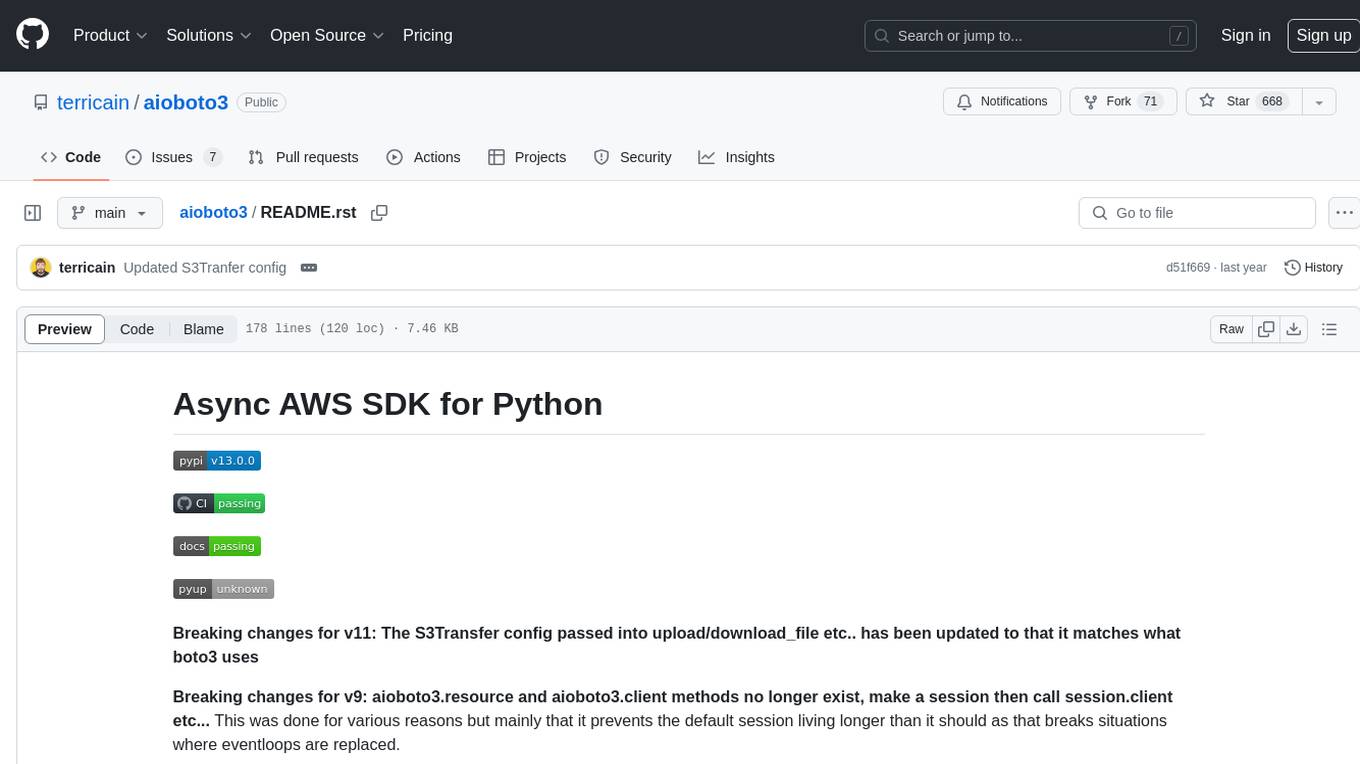
aioboto3
aioboto3 is an async AWS SDK for Python that allows users to use near enough all of the boto3 client commands in an async manner just by prefixing the command with `await`. It combines the great work of boto3 and aiobotocore, enabling users to use higher level APIs provided by boto3 in an asynchronous manner. The package provides support for various AWS services such as DynamoDB, S3, Kinesis, SSM Parameter Store, and Athena. It also offers features like client-side encryption using KMS-Managed master keys and supports asyncifying `get_presigned_url`. The library closely mimics the usage of boto3 and is mainly developed to be used in async microservices.
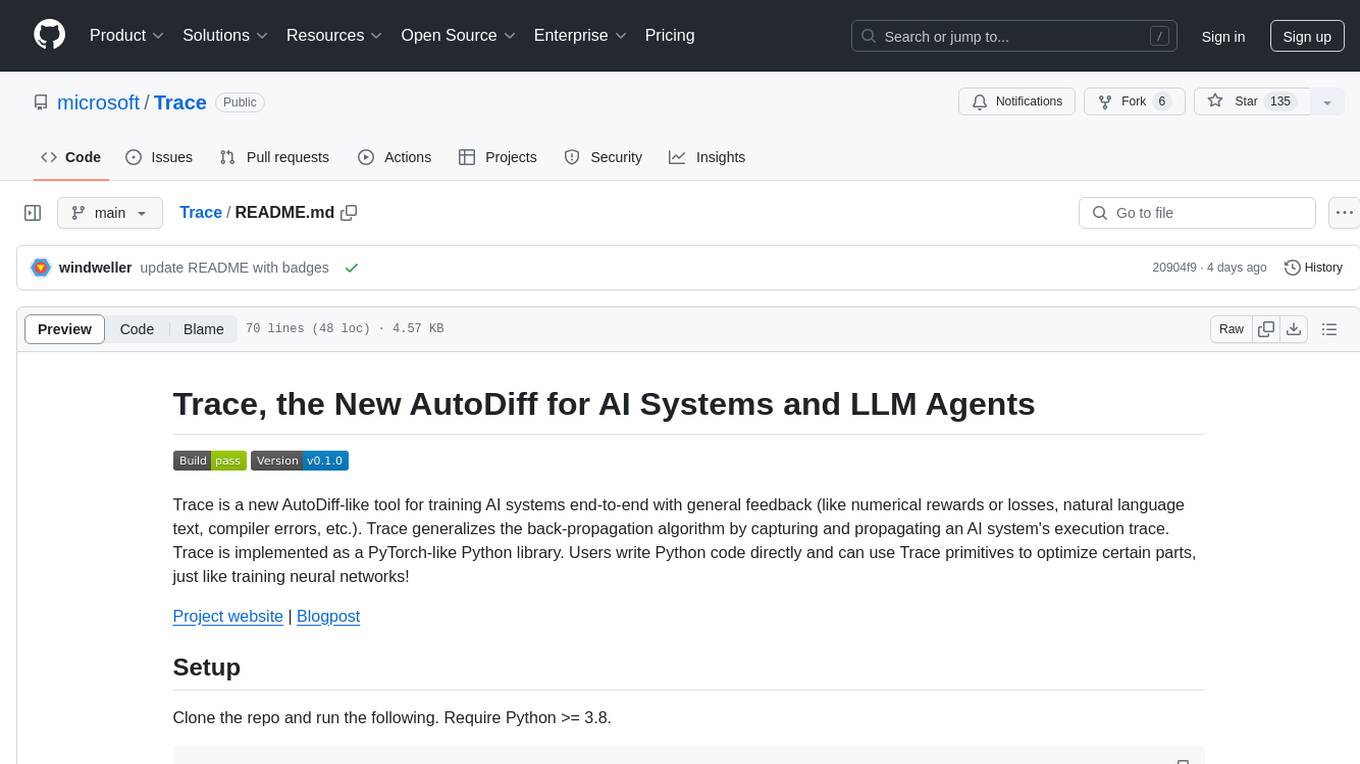
Trace
Trace is a new AutoDiff-like tool for training AI systems end-to-end with general feedback. It generalizes the back-propagation algorithm by capturing and propagating an AI system's execution trace. Implemented as a PyTorch-like Python library, users can write Python code directly and use Trace primitives to optimize certain parts, similar to training neural networks.
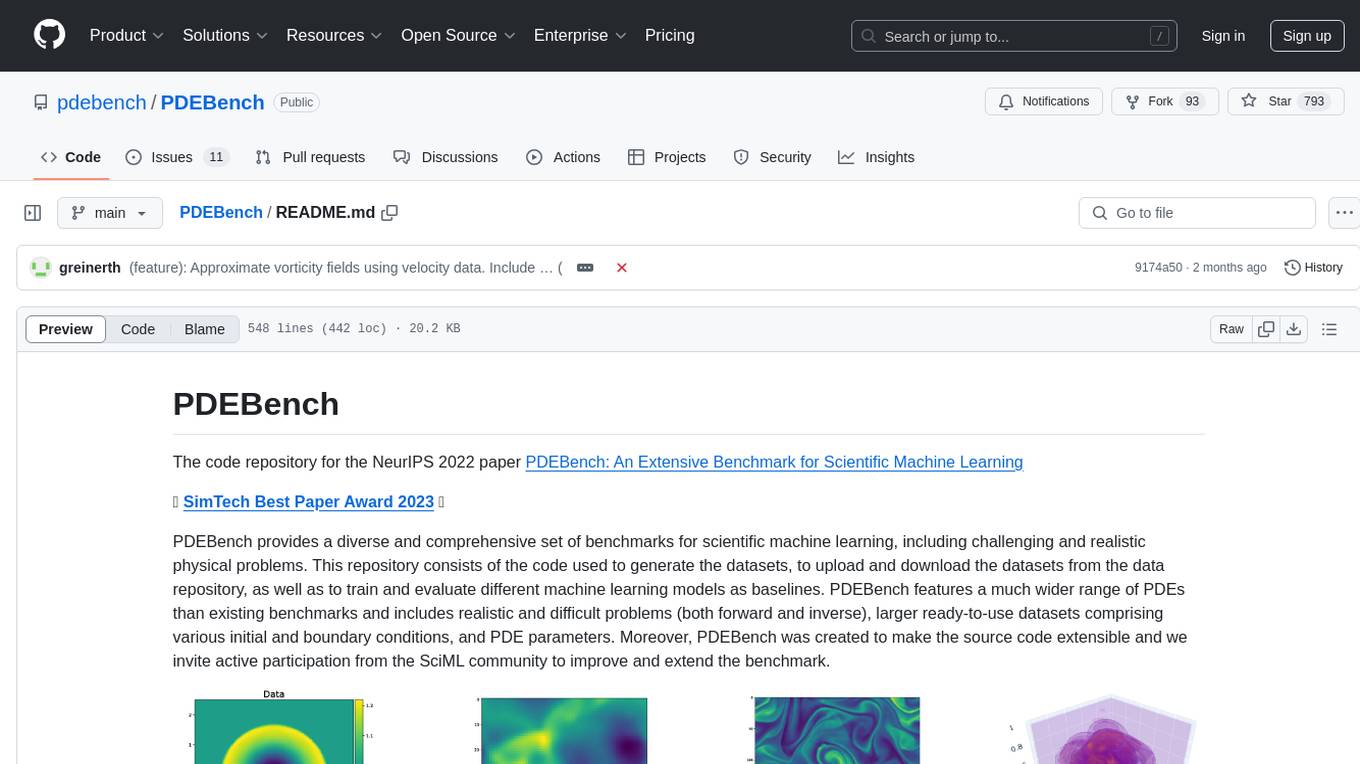
PDEBench
PDEBench provides a diverse and comprehensive set of benchmarks for scientific machine learning, including challenging and realistic physical problems. The repository consists of code for generating datasets, uploading and downloading datasets, training and evaluating machine learning models as baselines. It features a wide range of PDEs, realistic and difficult problems, ready-to-use datasets with various conditions and parameters. PDEBench aims for extensibility and invites participation from the SciML community to improve and extend the benchmark.
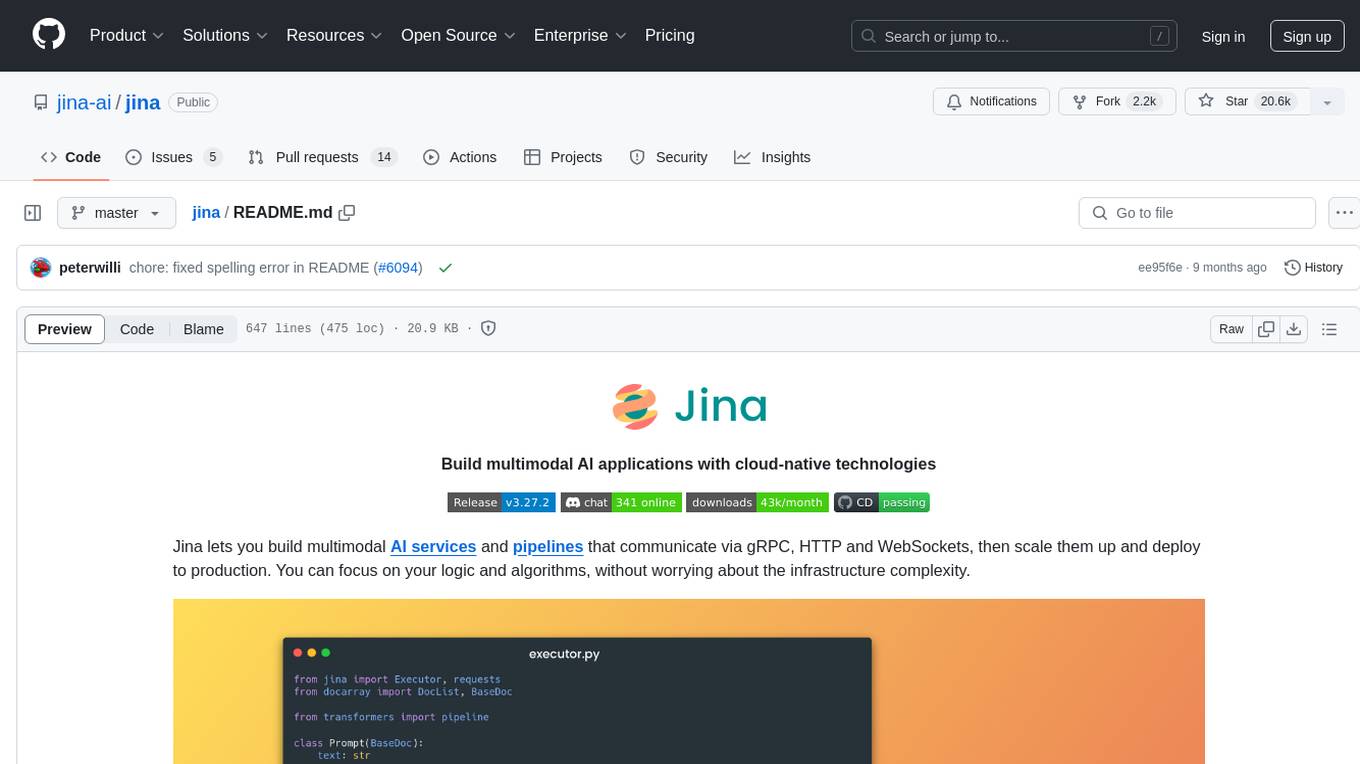
jina
Jina is a tool that allows users to build multimodal AI services and pipelines using cloud-native technologies. It provides a Pythonic experience for serving ML models and transitioning from local deployment to advanced orchestration frameworks like Docker-Compose, Kubernetes, or Jina AI Cloud. Users can build and serve models for any data type and deep learning framework, design high-performance services with easy scaling, serve LLM models while streaming their output, integrate with Docker containers via Executor Hub, and host on CPU/GPU using Jina AI Cloud. Jina also offers advanced orchestration and scaling capabilities, a smooth transition to the cloud, and easy scalability and concurrency features for applications. Users can deploy to their own cloud or system with Kubernetes and Docker Compose integration, and even deploy to JCloud for autoscaling and monitoring.
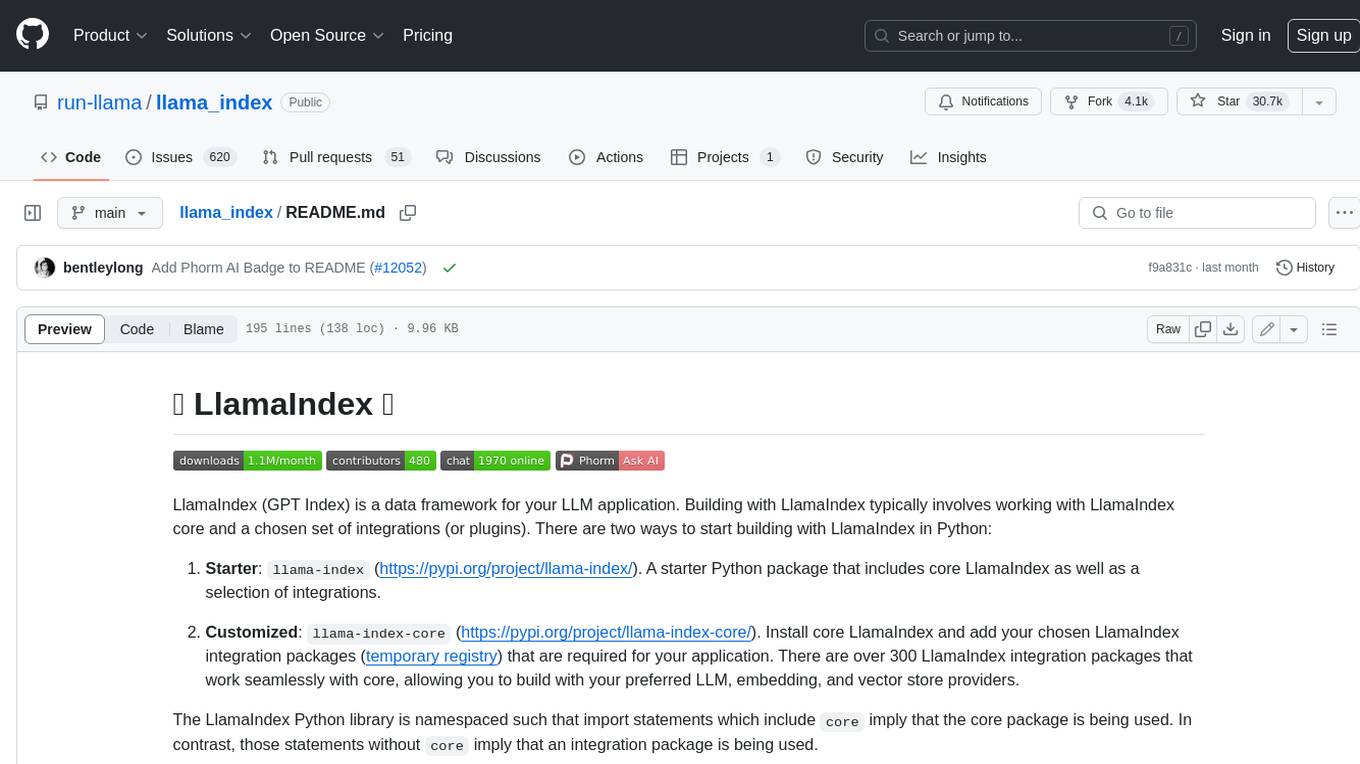
llama_index
LlamaIndex is a data framework for building LLM applications. It provides tools for ingesting, structuring, and querying data, as well as integrating with LLMs and other tools. LlamaIndex is designed to be easy to use for both beginner and advanced users, and it provides a comprehensive set of features for building LLM applications.
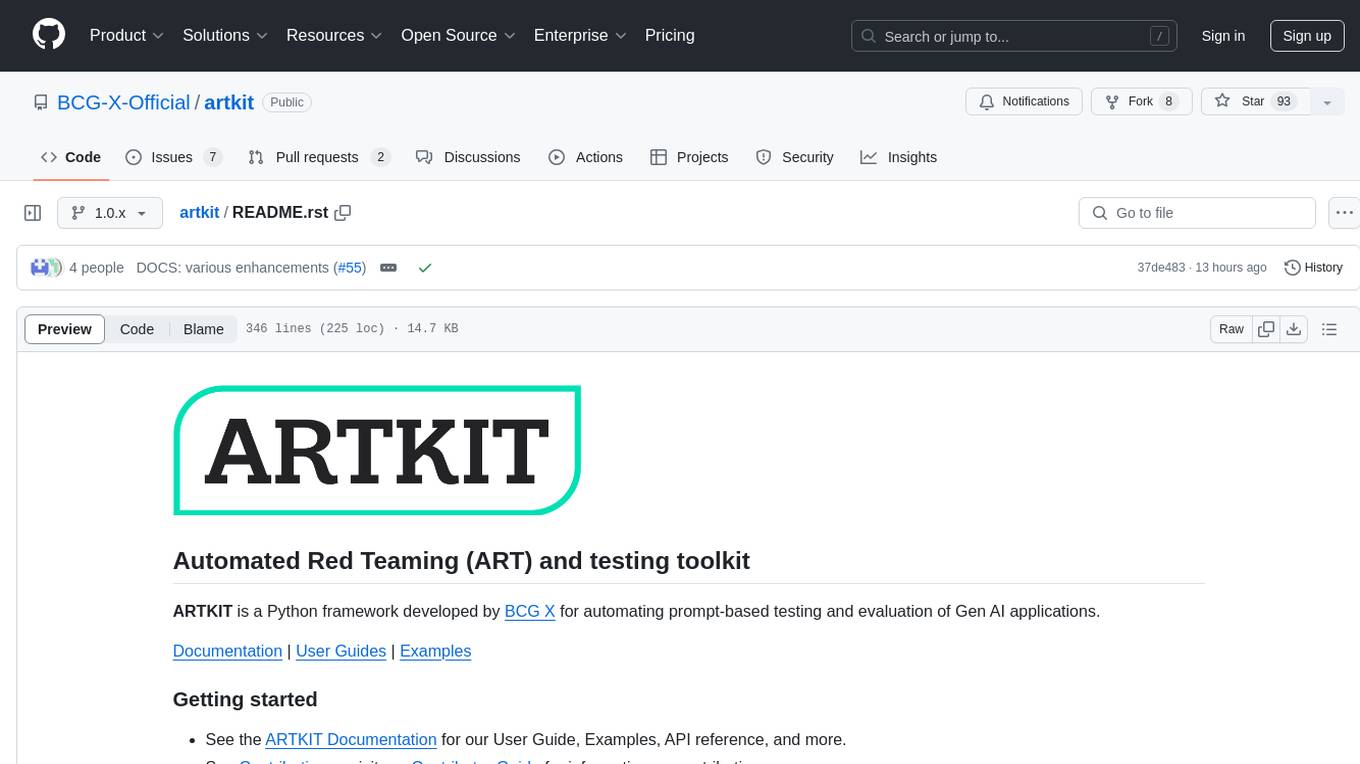
artkit
ARTKIT is a Python framework developed by BCG X for automating prompt-based testing and evaluation of Gen AI applications. It allows users to develop automated end-to-end testing and evaluation pipelines for Gen AI systems, supporting multi-turn conversations and various testing scenarios like Q&A accuracy, brand values, equitability, safety, and security. The framework provides a simple API, asynchronous processing, caching, model agnostic support, end-to-end pipelines, multi-turn conversations, robust data flows, and visualizations. ARTKIT is designed for customization by data scientists and engineers to enhance human-in-the-loop testing and evaluation, emphasizing the importance of tailored testing for each Gen AI use case.
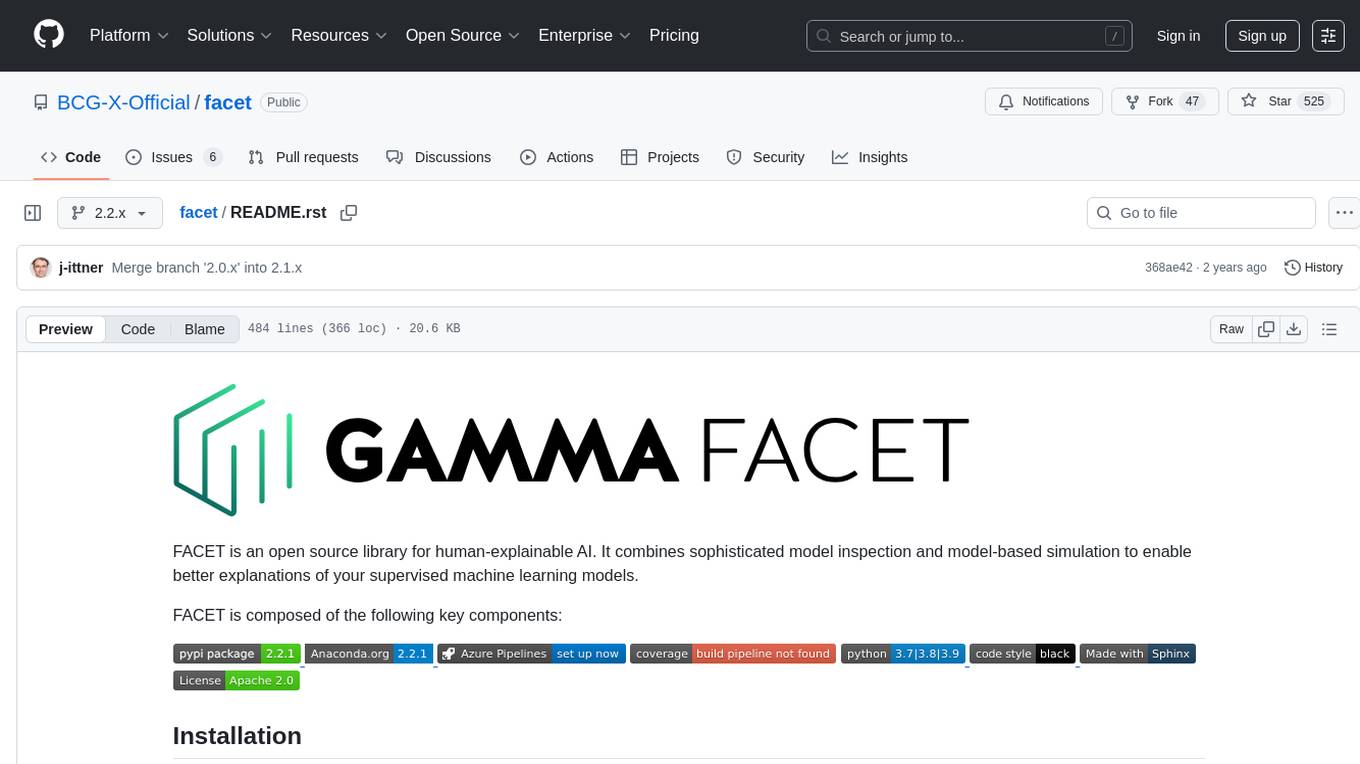
facet
FACET is an open source library for human-explainable AI that combines model inspection and model-based simulation to provide better explanations for supervised machine learning models. It offers an efficient and transparent machine learning workflow, enhancing scikit-learn's pipelining paradigm with new capabilities for model selection, inspection, and simulation. FACET introduces new algorithms for quantifying dependencies and interactions between features in ML models, as well as for conducting virtual experiments to optimize predicted outcomes. The tool ensures end-to-end traceability of features using an augmented version of scikit-learn with enhanced support for pandas data frames. FACET also provides model inspection methods for scikit-learn estimators, enhancing global metrics like synergy and redundancy to complement the local perspective of SHAP. Additionally, FACET offers model simulation capabilities for conducting univariate uplift simulations based on important features like BMI.
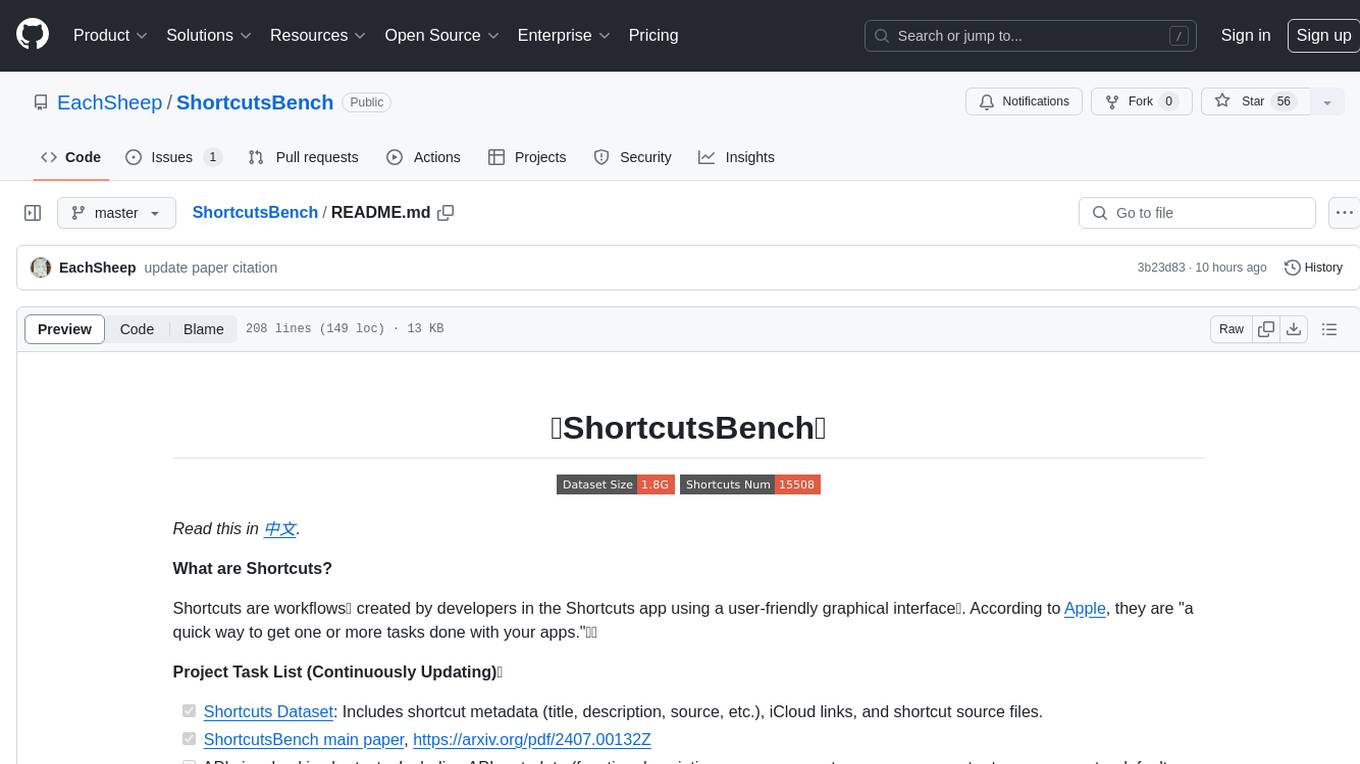
ShortcutsBench
ShortcutsBench is a project focused on collecting and analyzing workflows created in the Shortcuts app, providing a dataset of shortcut metadata, source files, and API information. It aims to study the integration of large language models with Apple devices, particularly focusing on the role of shortcuts in enhancing user experience. The project offers insights for Shortcuts users, enthusiasts, and researchers to explore, customize workflows, and study automated workflows, low-code programming, and API-based agents.
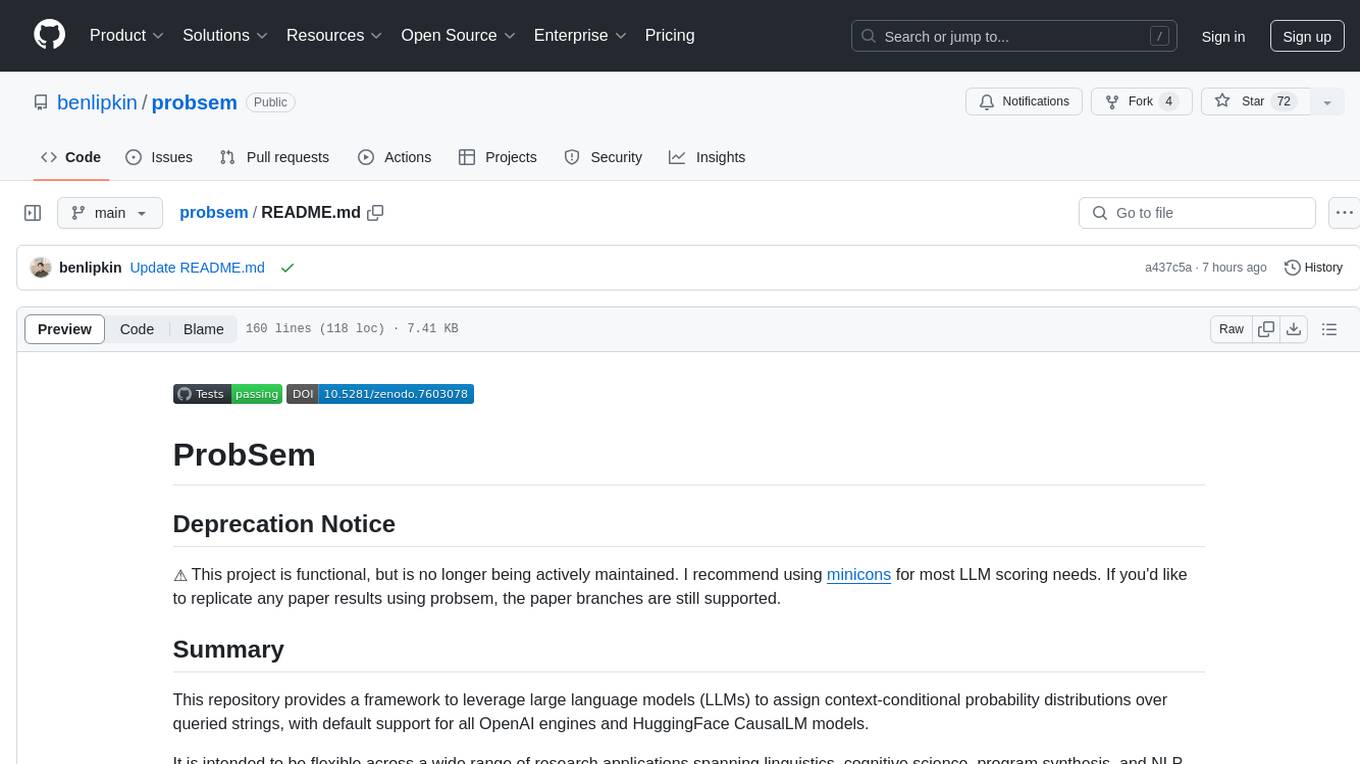
probsem
ProbSem is a repository that provides a framework to leverage large language models (LLMs) for assigning context-conditional probability distributions over queried strings. It supports OpenAI engines and HuggingFace CausalLM models, and is flexible for research applications in linguistics, cognitive science, program synthesis, and NLP. Users can define prompts, contexts, and queries to derive probability distributions over possible completions, enabling tasks like cloze completion, multiple-choice QA, semantic parsing, and code completion. The repository offers CLI and API interfaces for evaluation, with options to customize models, normalize scores, and adjust temperature for probability distributions.
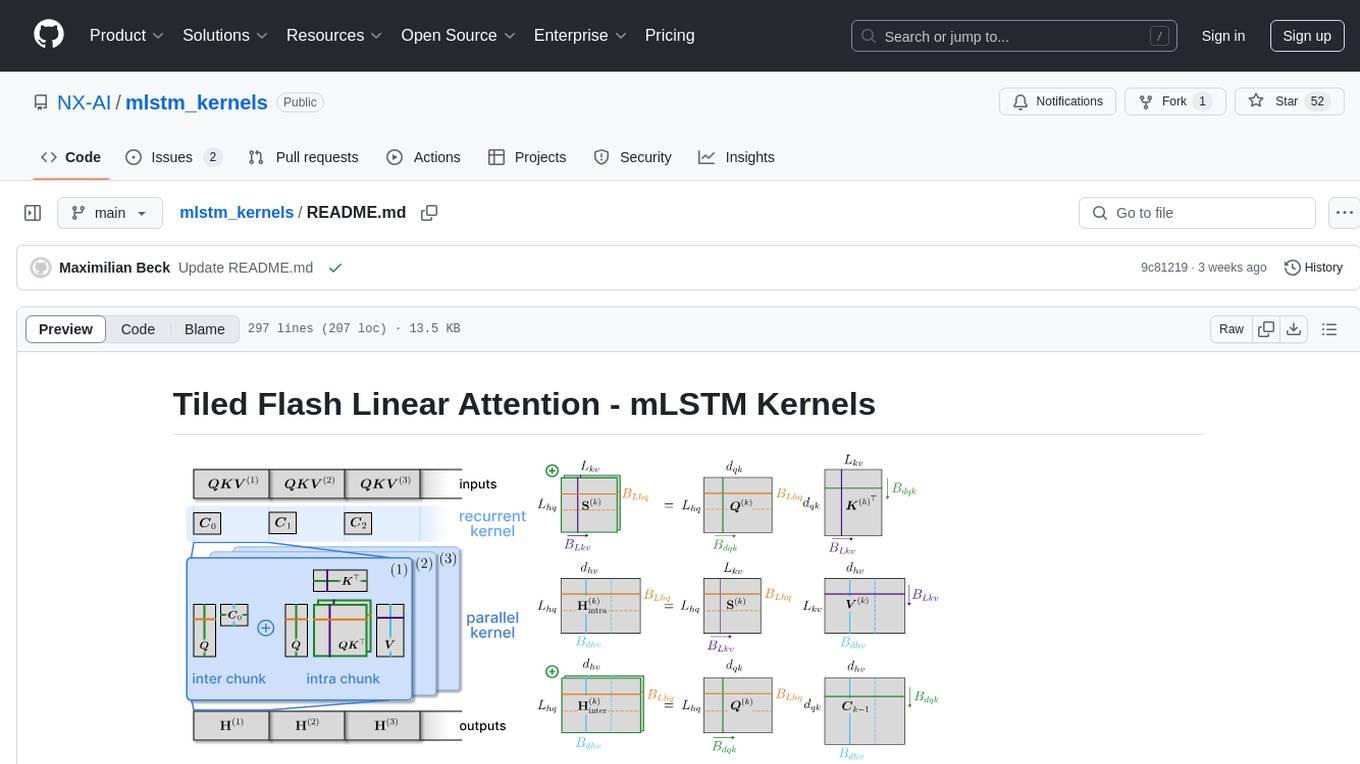
mlstm_kernels
This repository provides fast and efficient mLSTM training and inference Triton kernels built on Tiled Flash Linear Attention (TFLA). It includes implementations in JAX, PyTorch, and Triton, with chunkwise, parallel, and recurrent kernels for mLSTM. The repository also contains a benchmark library for runtime benchmarks and full mLSTM Huggingface models.
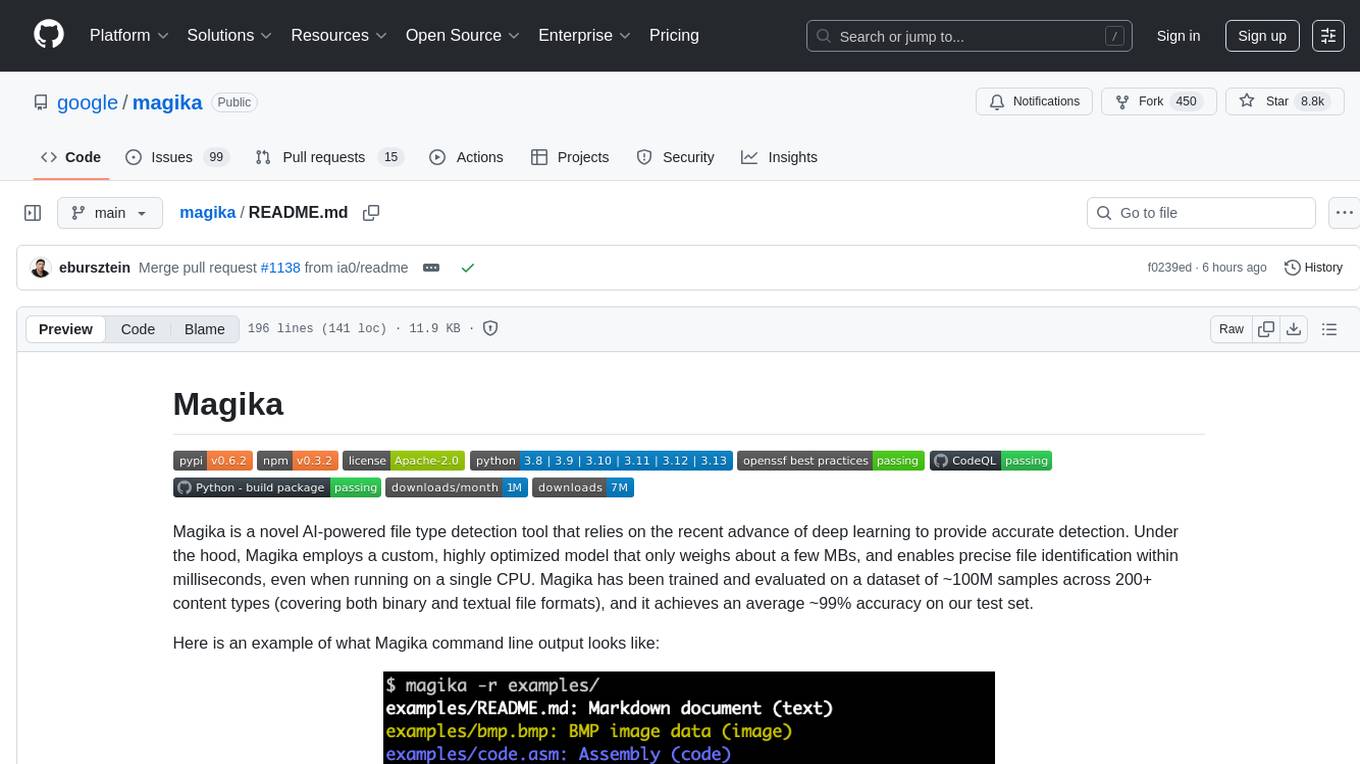
magika
Magika is a novel AI-powered file type detection tool that relies on deep learning to provide accurate detection. It employs a custom, highly optimized model to enable precise file identification within milliseconds. Trained on a dataset of ~100M samples across 200+ content types, achieving an average ~99% accuracy. Used at scale by Google to improve user safety by routing files to security scanners. Available as a command line tool in Rust, Python API, and bindings for Rust, JavaScript/TypeScript, and GoLang.
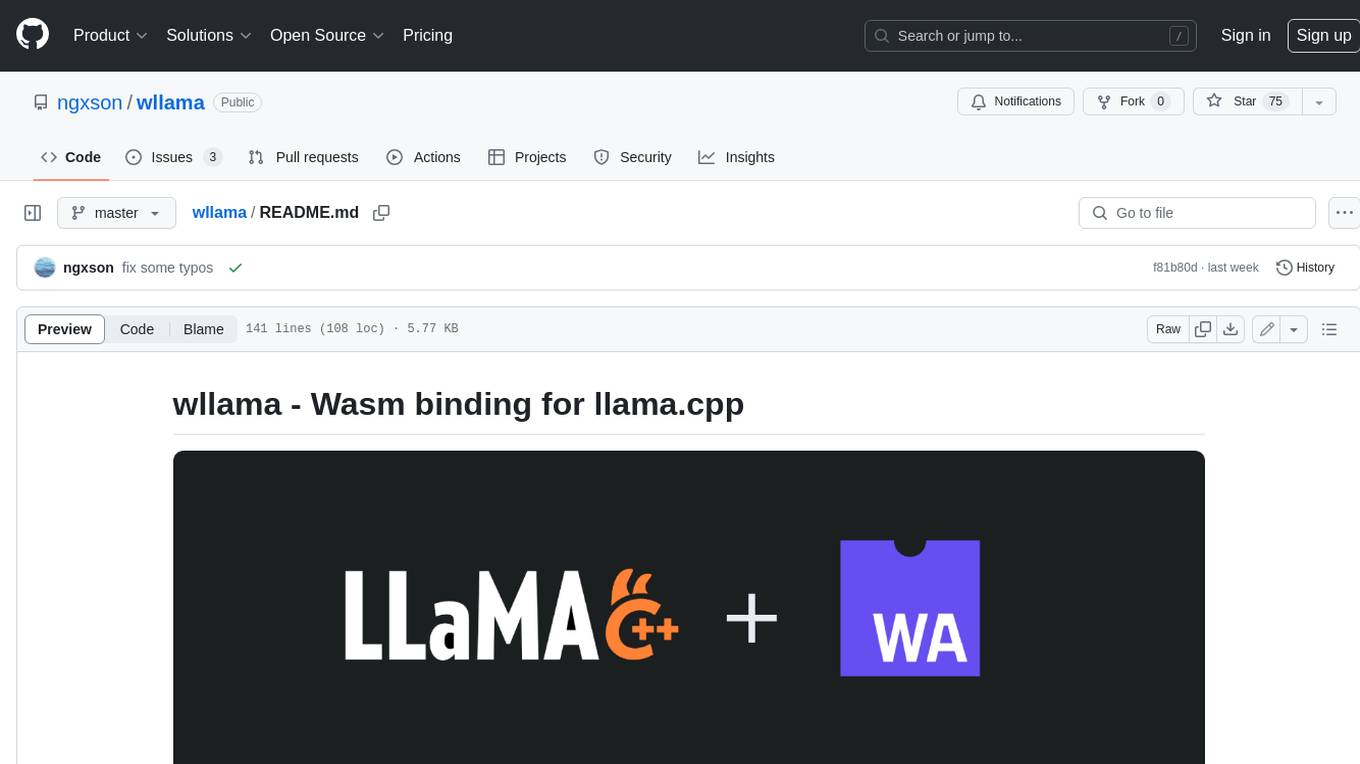
wllama
Wllama is a WebAssembly binding for llama.cpp, a high-performance and lightweight language model library. It enables you to run inference directly on the browser without the need for a backend or GPU. Wllama provides both high-level and low-level APIs, allowing you to perform various tasks such as completions, embeddings, tokenization, and more. It also supports model splitting, enabling you to load large models in parallel for faster download. With its Typescript support and pre-built npm package, Wllama is easy to integrate into your React Typescript projects.

raglite
RAGLite is a Python toolkit for Retrieval-Augmented Generation (RAG) with PostgreSQL or SQLite. It offers configurable options for choosing LLM providers, database types, and rerankers. The toolkit is fast and permissive, utilizing lightweight dependencies and hardware acceleration. RAGLite provides features like PDF to Markdown conversion, multi-vector chunk embedding, optimal semantic chunking, hybrid search capabilities, adaptive retrieval, and improved output quality. It is extensible with a built-in Model Context Protocol server, customizable ChatGPT-like frontend, document conversion to Markdown, and evaluation tools. Users can configure RAGLite for various tasks like configuring, inserting documents, running RAG pipelines, computing query adapters, evaluating performance, running MCP servers, and serving frontends.
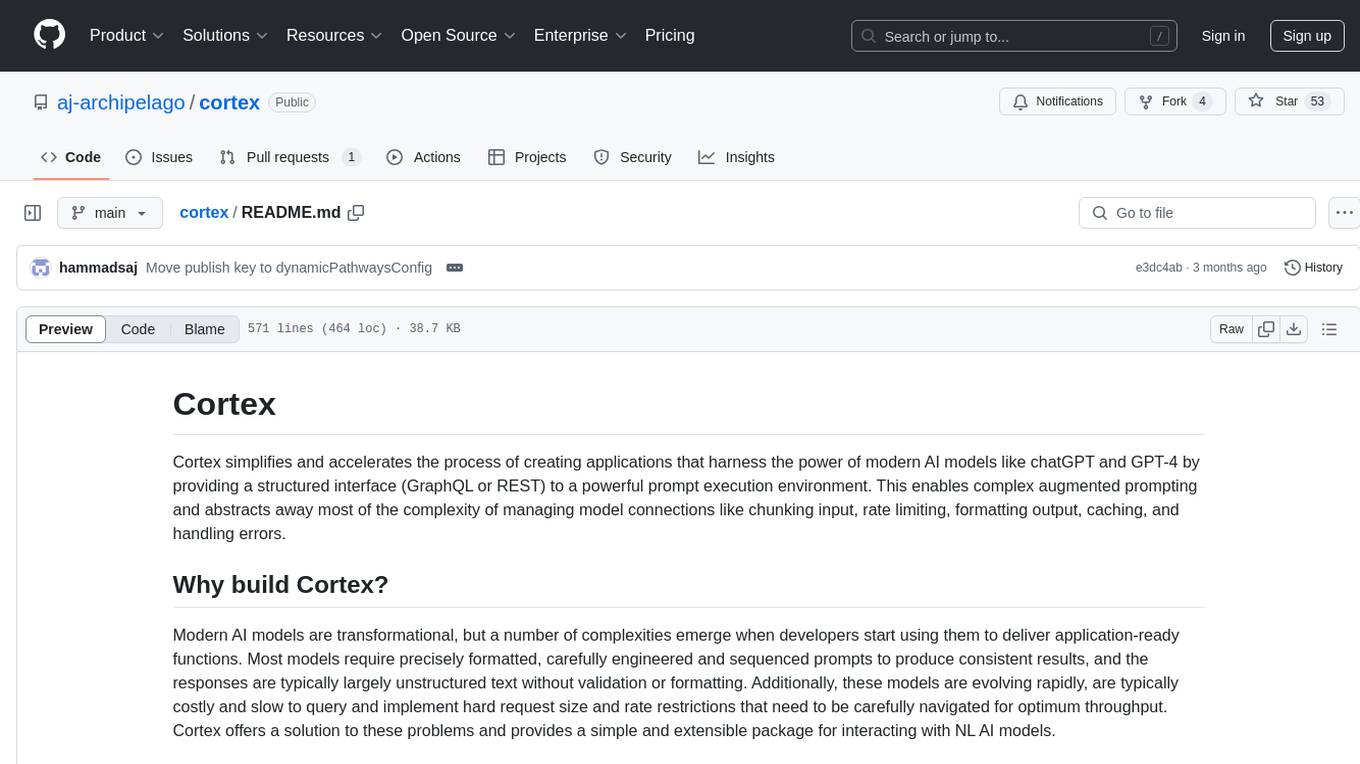
cortex
Cortex is a tool that simplifies and accelerates the process of creating applications utilizing modern AI models like chatGPT and GPT-4. It provides a structured interface (GraphQL or REST) to a prompt execution environment, enabling complex augmented prompting and abstracting away model connection complexities like input chunking, rate limiting, output formatting, caching, and error handling. Cortex offers a solution to challenges faced when using AI models, providing a simple package for interacting with NL AI models.
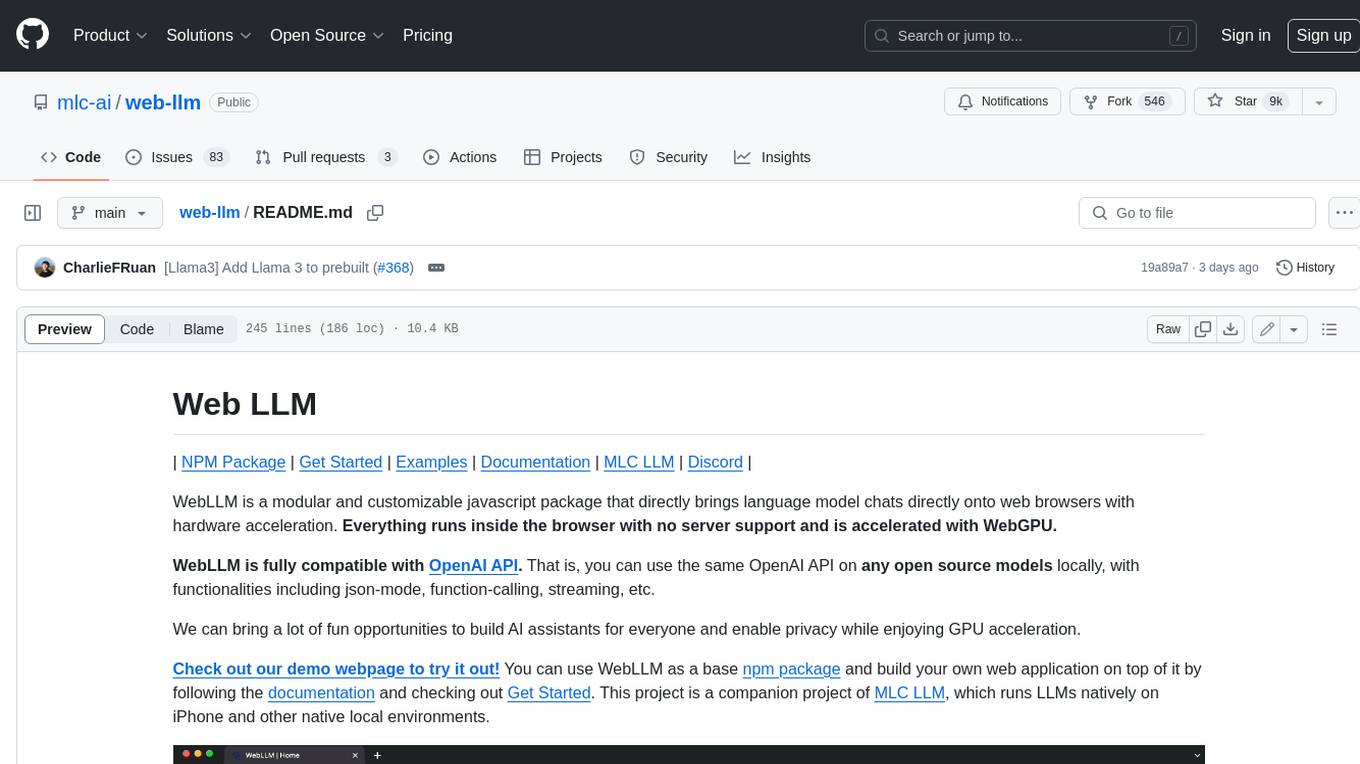
web-llm
WebLLM is a modular and customizable javascript package that directly brings language model chats directly onto web browsers with hardware acceleration. Everything runs inside the browser with no server support and is accelerated with WebGPU. WebLLM is fully compatible with OpenAI API. That is, you can use the same OpenAI API on any open source models locally, with functionalities including json-mode, function-calling, streaming, etc. We can bring a lot of fun opportunities to build AI assistants for everyone and enable privacy while enjoying GPU acceleration.
For similar tasks

aiomisc
aiomisc is a Python library that provides a collection of utility functions and classes for working with asynchronous I/O in a more intuitive and efficient way. It offers features like worker pools, connection pools, circuit breaker pattern, and retry mechanisms to make asyncio code more robust and easier to maintain. The library simplifies the architecture of software using asynchronous I/O, making it easier for developers to write reliable and scalable asynchronous code.
For similar jobs
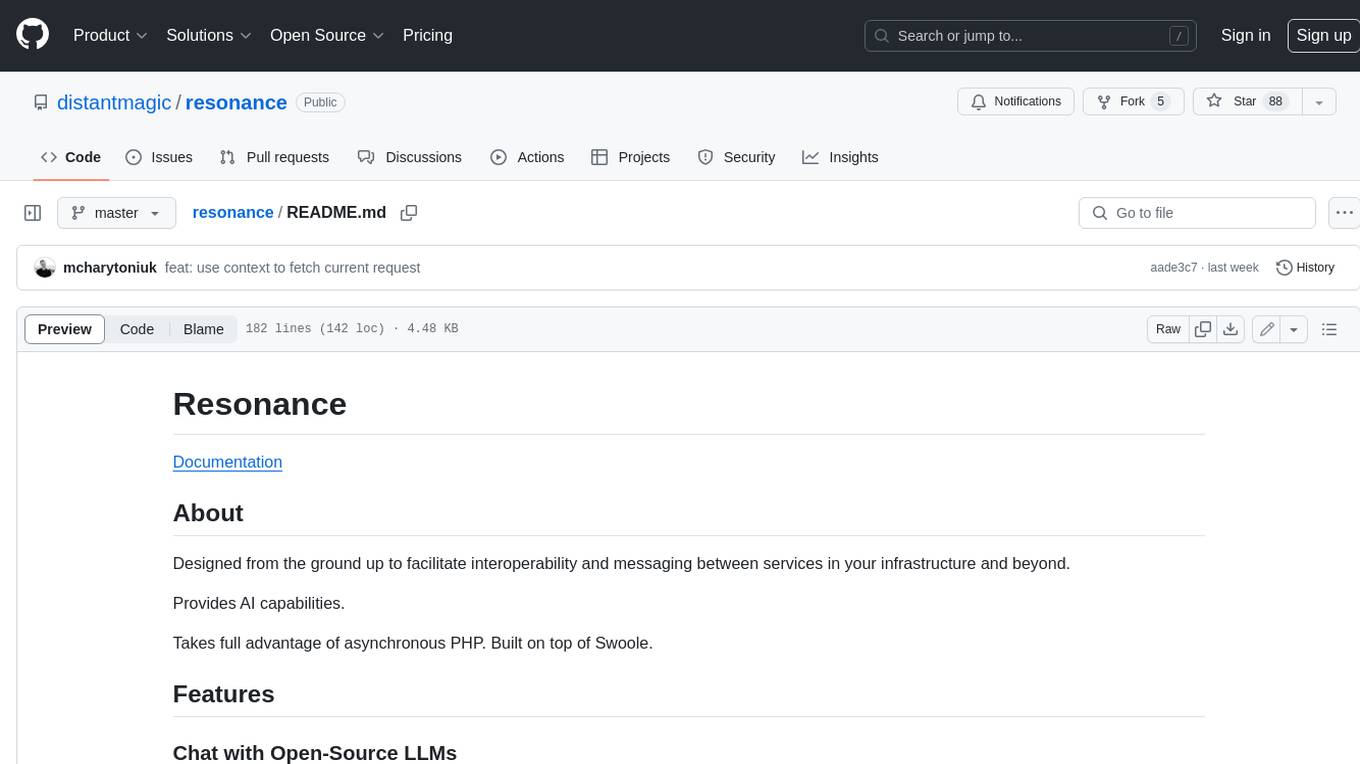
resonance
Resonance is a framework designed to facilitate interoperability and messaging between services in your infrastructure and beyond. It provides AI capabilities and takes full advantage of asynchronous PHP, built on top of Swoole. With Resonance, you can: * Chat with Open-Source LLMs: Create prompt controllers to directly answer user's prompts. LLM takes care of determining user's intention, so you can focus on taking appropriate action. * Asynchronous Where it Matters: Respond asynchronously to incoming RPC or WebSocket messages (or both combined) with little overhead. You can set up all the asynchronous features using attributes. No elaborate configuration is needed. * Simple Things Remain Simple: Writing HTTP controllers is similar to how it's done in the synchronous code. Controllers have new exciting features that take advantage of the asynchronous environment. * Consistency is Key: You can keep the same approach to writing software no matter the size of your project. There are no growing central configuration files or service dependencies registries. Every relation between code modules is local to those modules. * Promises in PHP: Resonance provides a partial implementation of Promise/A+ spec to handle various asynchronous tasks. * GraphQL Out of the Box: You can build elaborate GraphQL schemas by using just the PHP attributes. Resonance takes care of reusing SQL queries and optimizing the resources' usage. All fields can be resolved asynchronously.
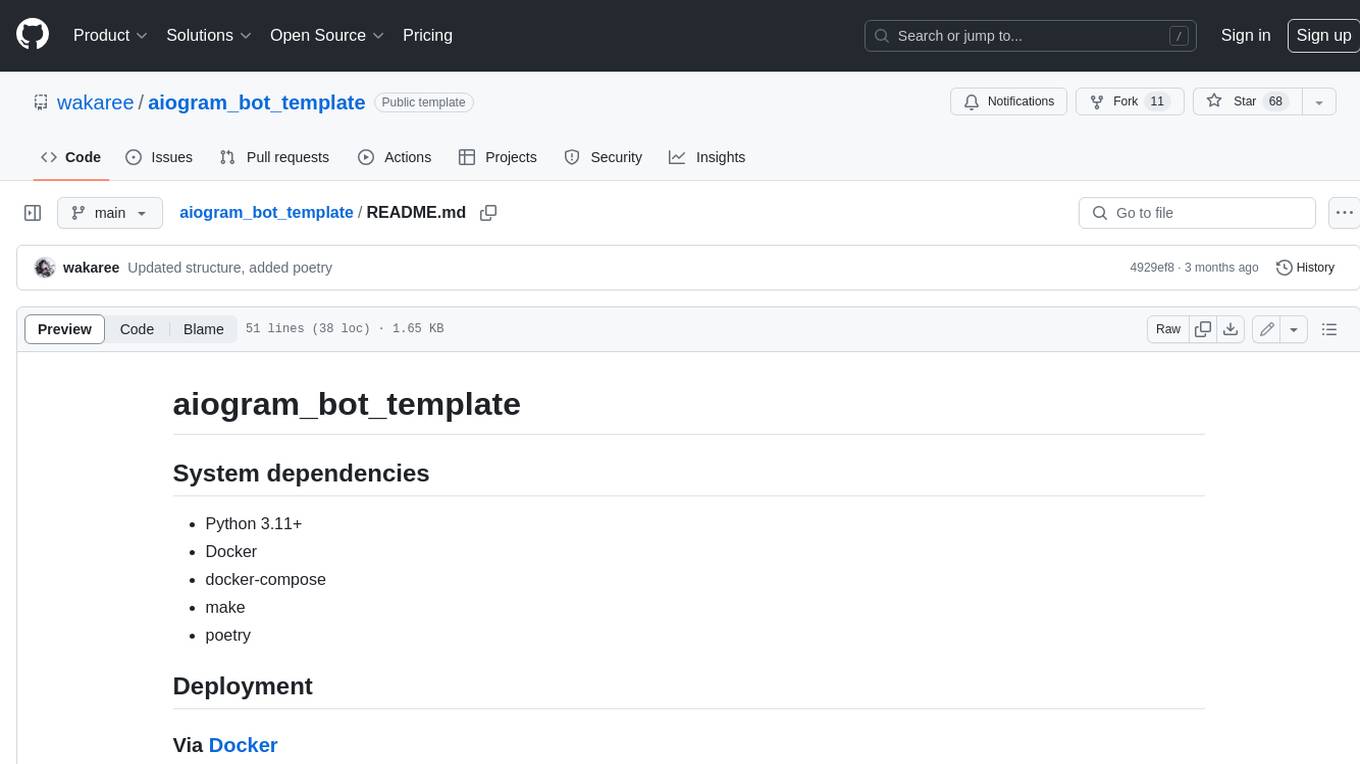
aiogram_bot_template
Aiogram bot template is a boilerplate for creating Telegram bots using Aiogram framework. It provides a solid foundation for building robust and scalable bots with a focus on code organization, database integration, and localization.
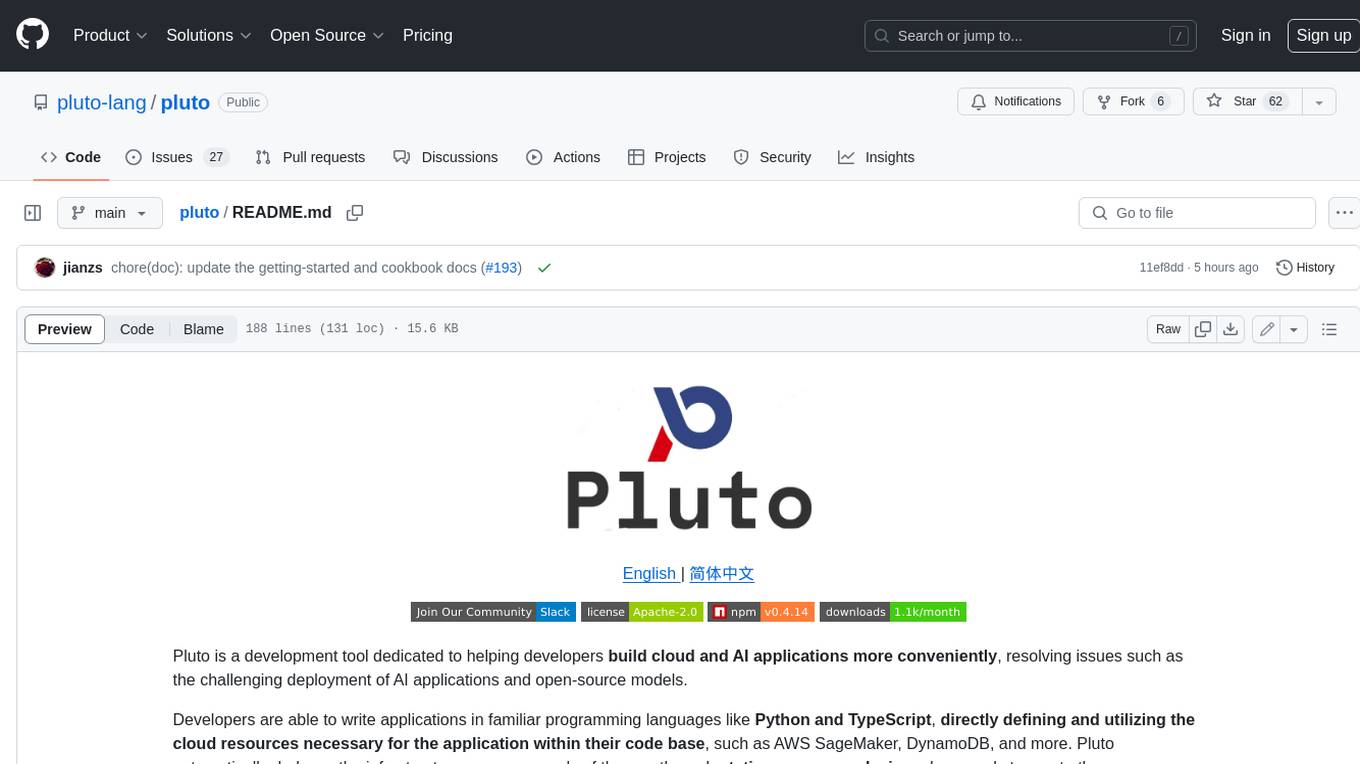
pluto
Pluto is a development tool dedicated to helping developers **build cloud and AI applications more conveniently** , resolving issues such as the challenging deployment of AI applications and open-source models. Developers are able to write applications in familiar programming languages like **Python and TypeScript** , **directly defining and utilizing the cloud resources necessary for the application within their code base** , such as AWS SageMaker, DynamoDB, and more. Pluto automatically deduces the infrastructure resource needs of the app through **static program analysis** and proceeds to create these resources on the specified cloud platform, **simplifying the resources creation and application deployment process**.
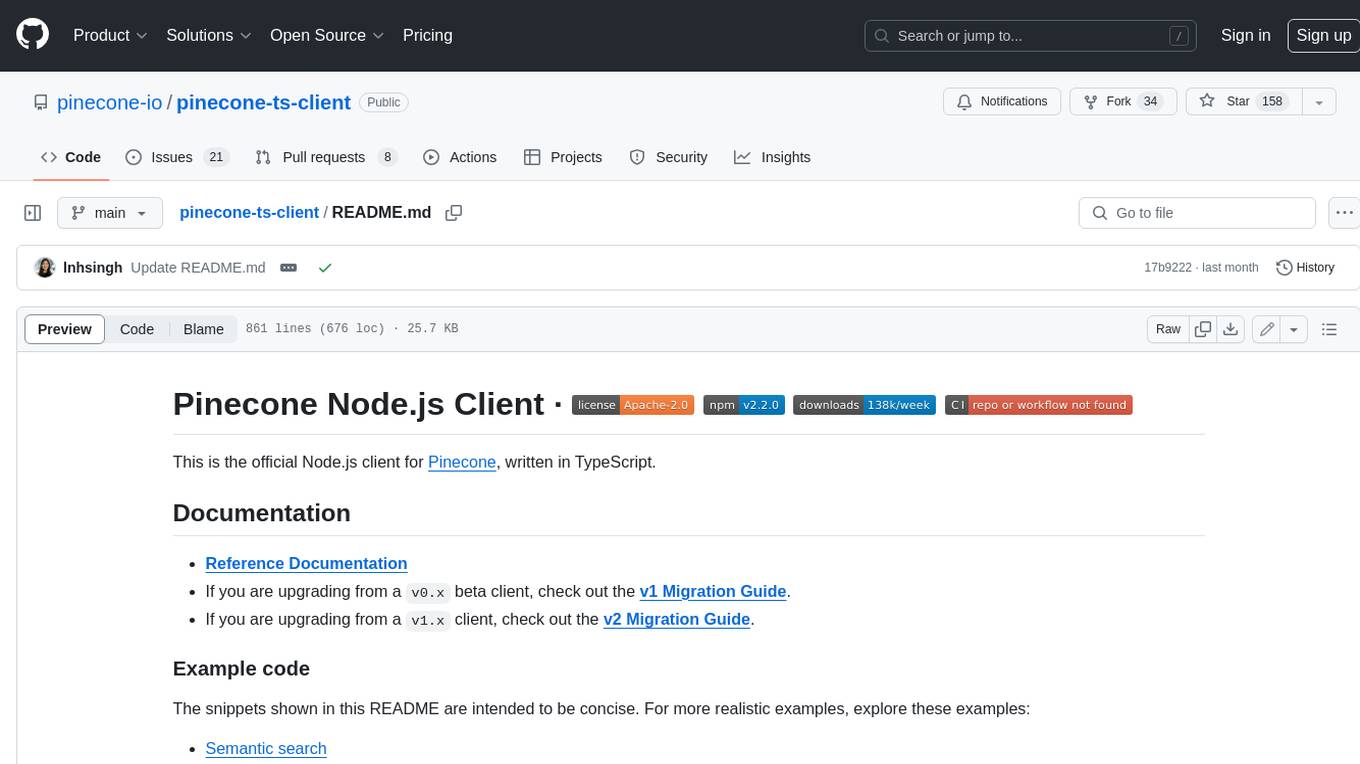
pinecone-ts-client
The official Node.js client for Pinecone, written in TypeScript. This client library provides a high-level interface for interacting with the Pinecone vector database service. With this client, you can create and manage indexes, upsert and query vector data, and perform other operations related to vector search and retrieval. The client is designed to be easy to use and provides a consistent and idiomatic experience for Node.js developers. It supports all the features and functionality of the Pinecone API, making it a comprehensive solution for building vector-powered applications in Node.js.
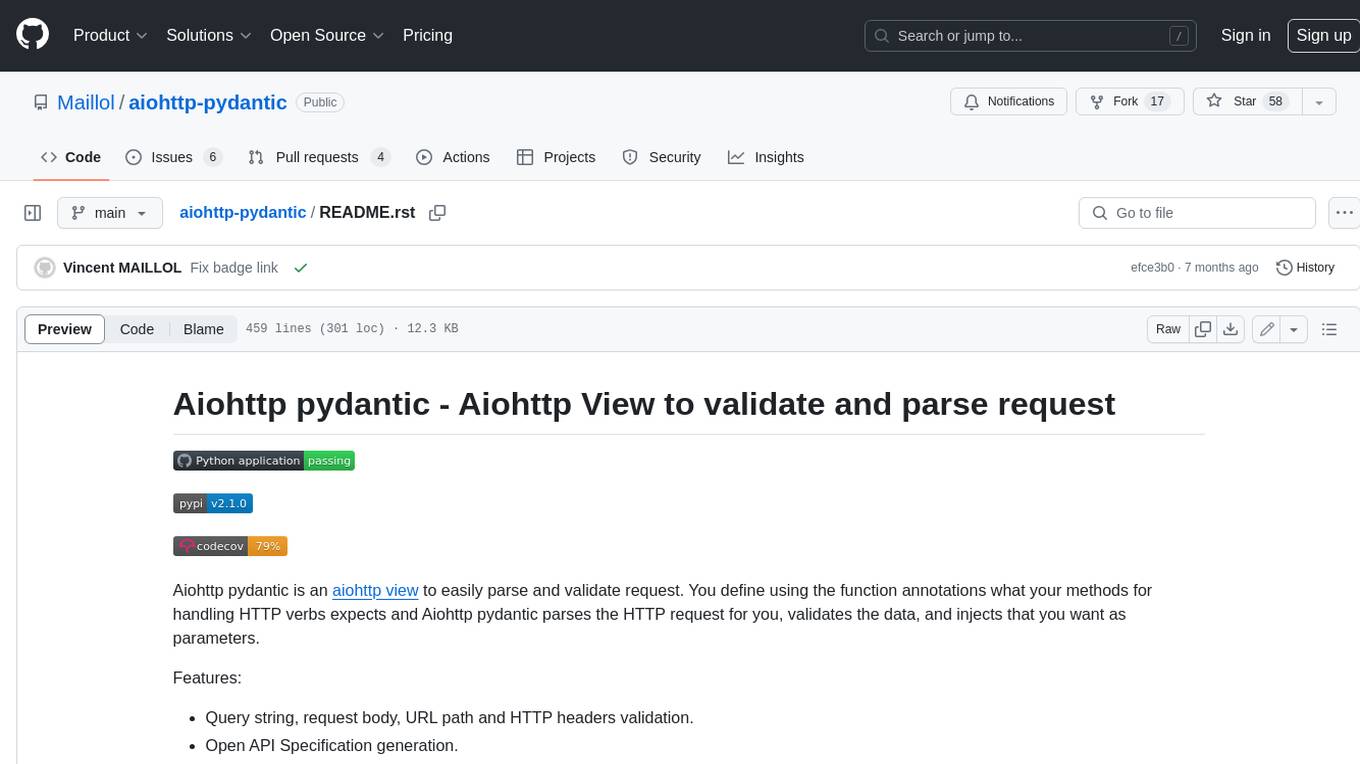
aiohttp-pydantic
Aiohttp pydantic is an aiohttp view to easily parse and validate requests. You define using function annotations what your methods for handling HTTP verbs expect, and Aiohttp pydantic parses the HTTP request for you, validates the data, and injects the parameters you want. It provides features like query string, request body, URL path, and HTTP headers validation, as well as Open API Specification generation.
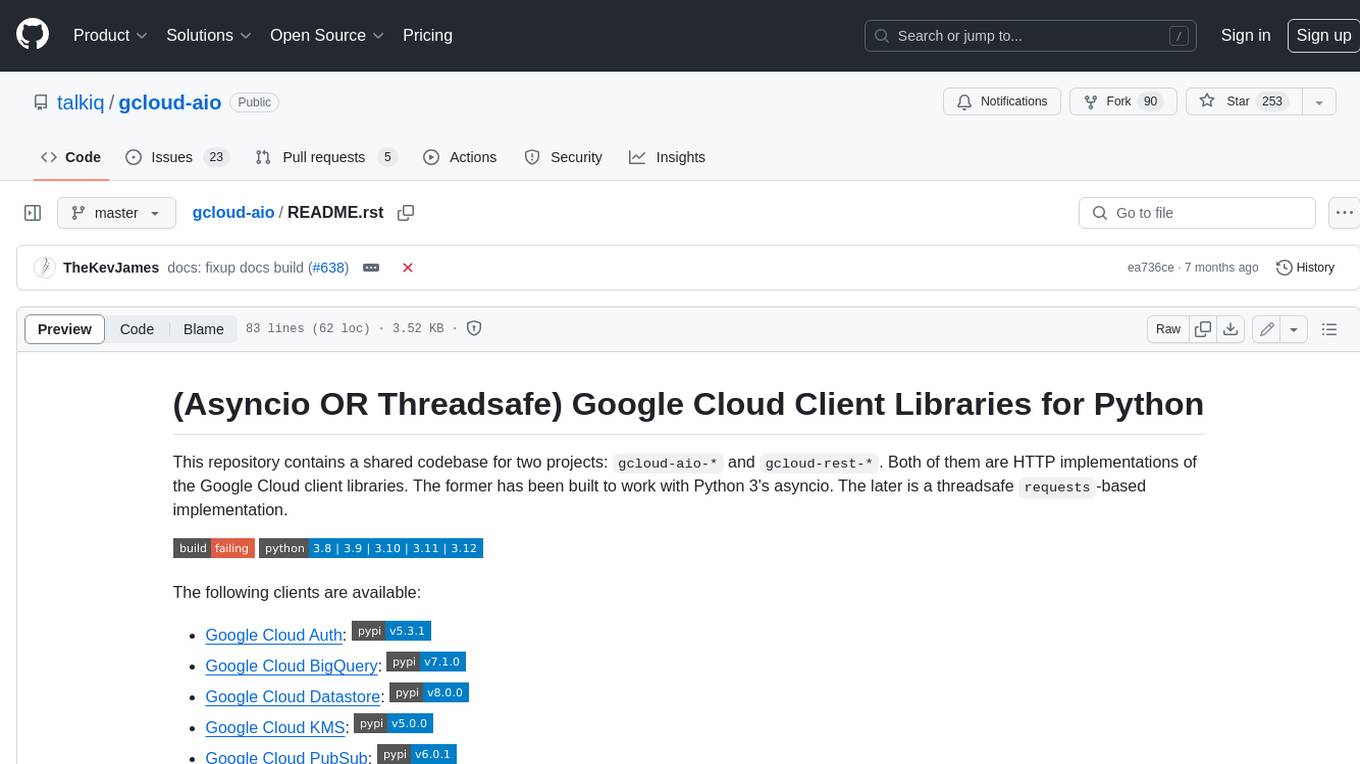
gcloud-aio
This repository contains shared codebase for two projects: gcloud-aio and gcloud-rest. gcloud-aio is built for Python 3's asyncio, while gcloud-rest is a threadsafe requests-based implementation. It provides clients for Google Cloud services like Auth, BigQuery, Datastore, KMS, PubSub, Storage, and Task Queue. Users can install the library using pip and refer to the documentation for usage details. Developers can contribute to the project by following the contribution guide.
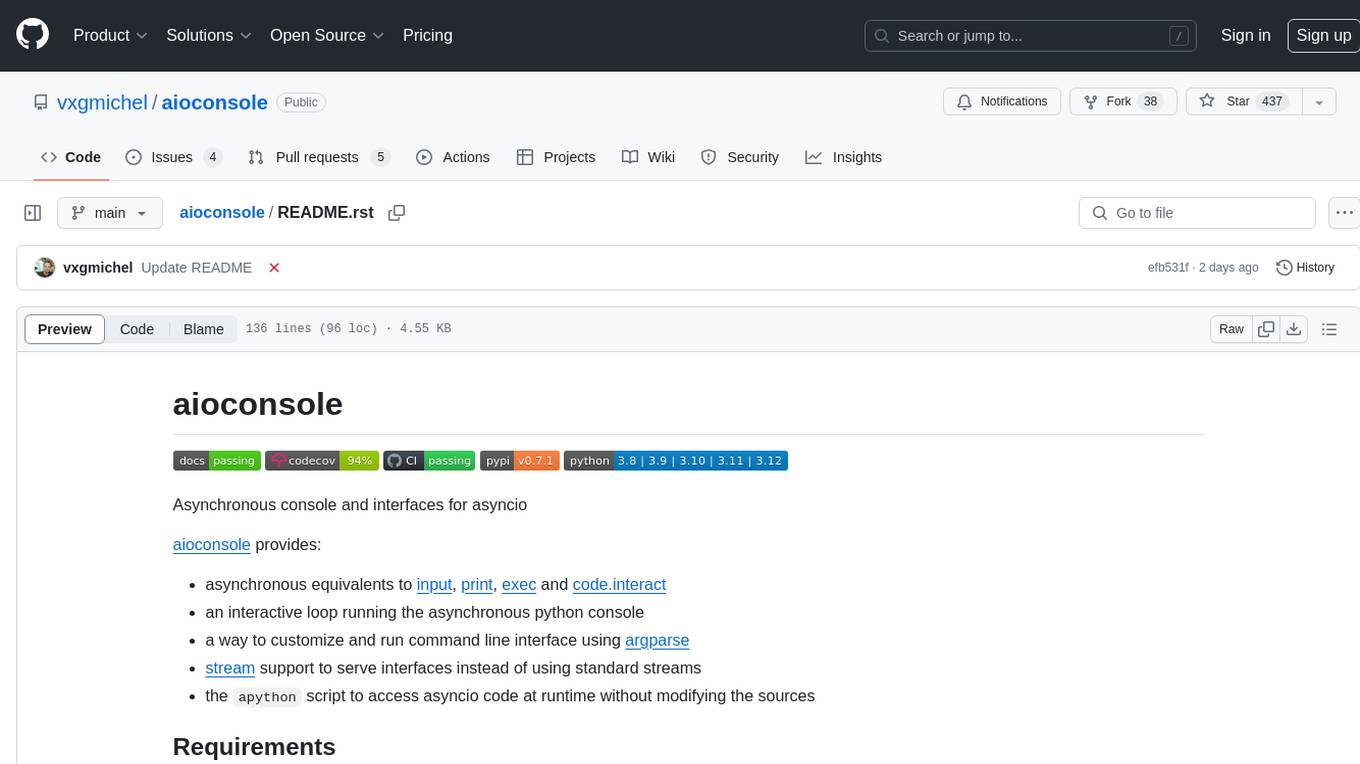
aioconsole
aioconsole is a Python package that provides asynchronous console and interfaces for asyncio. It offers asynchronous equivalents to input, print, exec, and code.interact, an interactive loop running the asynchronous Python console, customization and running of command line interfaces using argparse, stream support to serve interfaces instead of using standard streams, and the apython script to access asyncio code at runtime without modifying the sources. The package requires Python version 3.8 or higher and can be installed from PyPI or GitHub. It allows users to run Python files or modules with a modified asyncio policy, replacing the default event loop with an interactive loop. aioconsole is useful for scenarios where users need to interact with asyncio code in a console environment.
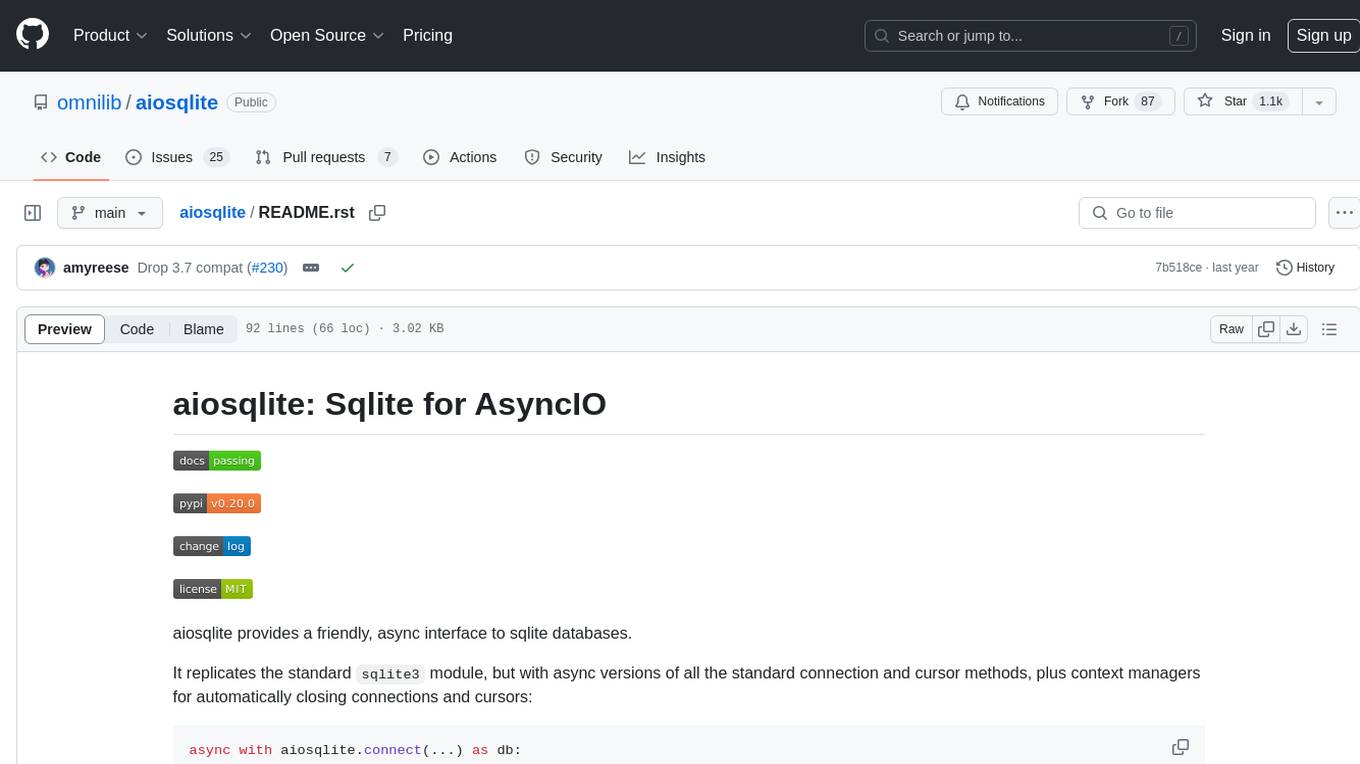
aiosqlite
aiosqlite is a Python library that provides a friendly, async interface to SQLite databases. It replicates the standard sqlite3 module but with async versions of all the standard connection and cursor methods, along with context managers for automatically closing connections and cursors. It allows interaction with SQLite databases on the main AsyncIO event loop without blocking execution of other coroutines while waiting for queries or data fetches. The library also replicates most of the advanced features of sqlite3, such as row factories and total changes tracking.